The Impact of Socio-Economic Indicators on Sustainable Consumption of Domestic Electricity in Lithuania
Abstract
:1. Introduction
2. Materials and Methods
2.1. Literature Review
2.1.1. The Issues of Sustainable Use of Energy
2.1.2. The Importance of Energy Saving in Households
2.1.3. The Factors Affecting Household Electricity Consumption
2.2. Data and Methodology
- unemployment (%),
- ratio of the registered unemployed to the working-age population (%),
- gross monthly average earnings (euro),
- net monthly average earnings (euro),
- basic monthly wage (euro),
- basic social benefit (euro),
- average disposable income per month in cash and kind per household (euro),
- average disposable income per month in cash and kind per capita (euro),
- average disposable income per month in cash per household (euro),
- average disposable income per month in cash per capita (euro),
- a heavy burden of housing expenses on households (%),
- a slight burden of housing expenses on households (%),
- not burden of housing expenses on households at all (%),
- at-risk-of-poverty threshold, type of household: single person (euro per month),
- at-risk-of-poverty threshold, type of household: 2 adults with 2 children younger than 14 years (euro per month),
- at-risk-of-poverty gap (%),
- at-risk-of-poverty rate (%),
- gross domestic product (GDP) at current prices (million euro),
- GDP per capita at current prices (euro),
- mean equivalised net income (euro),
- median equivalised net income (euro),
- overcrowding rate (% of total population),
- housing cost overburden rate (% of total population).
- Unit root test or Augmented Dickey-Fuller (ADF) test was used in order to test if the processes are stationary. It estimates the following regression:
- A long-run equilibrium relationship between residential electricity consumption per capita (kWh) and other indicators under investigation can be obtained through the application of the cointegration technique. Cointegration test of Engle and Granger, which is built on the ADF test, was used for that. Cointegration is supported if null hypothesis of non-stationarity is not rejected for each of the series individually but the null hypothesis is rejected for the residuals. Log values of the variables were used for these calculations.
- If two or more time-series are cointegrated, then there must be Granger causality between them—either one-way or in both directions. Granger causality test was performed in order to evaluate if socio-economic indicators Granger cause residential electricity consumption per capita and not vice versa (both directions are also eligible). The Granger approach to the question of whether x causes y is to see how much of the current y can be explained by past values of y and then to see whether addition of the lagged values of x can improve the explanation. y is said to be Granger-caused by x if x helps to predict y, or equivalently if the coefficients of the lagged x are statistically significant. VAR model is created in the levels of the data and it take the following form:
- Vector Error Correction Model (VECM) allows embed a representation of equilibrium relationships. Firstly, “unrestricted” (or conventional) error-correction model (ECM) is formulated using log values of the variables. In the case of three explanatory variables it can be written as follows:
3. Results
3.1. Energy Consumption in Lithuania
3.2. Electricity Consumption in Lithuania
3.3. The Impact of Economic and Social Factors on Household Electricity Consumption
4. Discussion
Author Contributions
Conflicts of Interest
References
- Ates, S.A.; Durakbasa, N.M. Evaluation of corporate energy management practices of energy intensive industries in Turkey. Energy 2012, 45, 81–91. [Google Scholar] [CrossRef]
- Kahraman, C.; Kaya, I. A fuzzy multi-criteria methodology for selection among energy alternatives. Expert Syst. Appl. 2010, 37, 6270–6281. [Google Scholar] [CrossRef]
- Zolfani, S.H.; Saparauskas, J. New application of SWARA method in prioritizing sustainability assessment indicators of energy system. Eng. Econ. 2013, 24, 408–414. [Google Scholar] [CrossRef]
- Klevas, V.; Streimikiene, D.; Grikstaite, R. Sustainable energy in Baltic States. Energy Policy 2007, 35, 76–90. [Google Scholar] [CrossRef]
- Bilgen, S.; Keles, S.; Kaygusuz, A.; Sari, A.; Kaygusuz, K. Global warming and renewable energy sources for sustainable development: A case study in Turkey. Renew. Sustain. Energy Rev. 2008, 12, 372–396. [Google Scholar] [CrossRef]
- Omer, A.M. Energy, environment and sustainable development. Renew. Sustain. Energy Rev. 2008, 12, 2265–2300. [Google Scholar] [CrossRef]
- Yuksel, I. Hydropower in Turkey for a clean and sustainable energy future. Renew. Sustain. Energy Rev. 2008, 12, 1622–1640. [Google Scholar] [CrossRef]
- Directive 2012/27/EU of the European Parliament and of the Council of 25 October 2012 on Energy Efficiency, Amending Directives 2009/125/EC and 2010/30/EU and Repealing Directives 2004/8/EC and 2006/32/EC. Available online: http://eur-lex.europa.eu/legal-content/EN/TXT/?uri=celex%3A32012L0027 (accessed on 20 November 2017).
- Dahlquist, E.; Vassileva, I.; Thorin, E.; Wallin, F. How to save energy to reach a balance between production and consumption of heat, electricity and fuels for vehicles. Energy 2012, 46, 16–20. [Google Scholar] [CrossRef]
- Filippini, M.; Hunt, L.C.; Zoric, J. Impact of energy policy instruments on the estimated level of underlying energy efficiency in the EU residential sector. Energy Policy 2014, 69, 73–81. [Google Scholar] [CrossRef]
- Yohanis, Y.G.; Mondol, J.D.; Wright, A.; Norton, B. Real-life energy use in the UK: How occupancy and dwelling characteristics affect domestic electricity use. Energy Build. 2008, 40, 1053–1059. [Google Scholar] [CrossRef]
- Communication from the Commission to the European Parliament, the Council, the European Economic and Social Committee and the Committee of the Regions. Energy 2020—A Strategy for Competitive, Sustainable and Secure Energy. COM (2010) 639 Final, Brussels. 10 November 2010. Available online: http://eur-lex.europa.eu/legal-content/EN/TXT/?uri=celex:52010DC0639 (accessed on 20 November 2017).
- Chontanawat, J.; Hunt, L.C.; Pierse, R. Does energy consumption cause economic growth? Evidence from a systematic study of over 100 countries. J. Policy Model. 2008, 30, 209–220. [Google Scholar] [CrossRef]
- Lee, C. Energy consumption and GDP in developing countries: A cointegrated panel analysis. Energy Econ. 2005, 27, 415–427. [Google Scholar] [CrossRef]
- Soytas, U.; Sari, R. Energy consumption and GDP: Causality relationship in G-7 countries and emerging markets. Energy Econ. 2003, 25, 33–37. [Google Scholar] [CrossRef]
- Filippini, M.; Hunt, L.C. US residential energy demand and energy efficiency: A stochastic demand frontier approach. Energy Econ. 2012, 34, 1484–1491. [Google Scholar] [CrossRef]
- Filippini, M.; Hunt, L.C. Underlying Energy Efficiency in the US; School of Economics, University of Surrey: Guildford, UK, 2015; Available online: http://www.seec.surrey.ac.uk/research/SEEDS/SEEDS150.pdf (accessed on 12 October 2017).
- Schlor, H.; Fischer, W.; Hake, J.F. Methods of measuring sustainable development of the German energy sector. Appl. Energy 2013, 101, 172–181. [Google Scholar] [CrossRef]
- Lior, N. Sustainable energy development with some game-changers. Energy 2012, 40, 3–18. [Google Scholar] [CrossRef]
- Asafu-Adjaye, J. The relationship between energy consumption, energy prices and economic growth: Time series evidence from Asian developing countries. Energy Econ. 2000, 22, 615–625. [Google Scholar] [CrossRef]
- Daioglou, V.; Faaij, A.P.C.; Saygin, D.; Patel, M.K.; Wicke, B.; van Vuuren, D.P. Energy demand and emissions of the non-energy sector. Energy Environ. Sci. 2014, 7, 482–498. [Google Scholar] [CrossRef]
- Phdungsilp, A. Projections of energy use and carbon emissions for Bangkok, Thailand. J. Rev. Glob. Econ. 2017, 6, 248–257. [Google Scholar] [CrossRef]
- Phdungsilp, A.; Wuttipornpun, T. Energy and carbon modeling with multi-criteria decision-making towards sustainable industrial sector development in Thailand. Low Carbon Econ. 2011, 2, 165–172. [Google Scholar] [CrossRef]
- Saygin, D.; Worrell, E.; Patel, M.K.; Gielen, D.J. Benchmarking the energy use of energy-intensive industries in industrialized and in developing countries. Energy 2011, 36, 6661–6673. [Google Scholar] [CrossRef]
- Saygin, D.; Worrell, E.; Tam, C.; Trudeau, N.; Gielen, D.J.; Weiss, M.; Patel, M.K. Long-term energy efficiency analysis requires solid energy statistics: The case of the German basic chemical industry. Energy 2012, 44, 1094–1106. [Google Scholar] [CrossRef]
- Siitonen, S.; Tuomaala, M.; Ahtila, P. Variables affecting energy efficiency and CO2 emissions in the steel industry. Energy Policy 2010, 38, 2477–2485. [Google Scholar] [CrossRef]
- Brosch, T.; Patel, M.K.; Sander, D. Affective influences on energy-related decisions and behaviors. Front. Energy Res. 2014, 2, 1–12. [Google Scholar] [CrossRef]
- Srovnalikova, P.; Karbach, R. Tax Changes and Their Impact on Managerial Decision Making. In Proceedings of the 1st International Conference Contemporary Issues in Theory and Practice of Management (CITPM 2016), Czestochowa, Poland, 21–22 April 2016; Okreglicka, M., Gorzen-Mitka, I., Lemanska-Majdzik, A., Sipa, M., Skibinski, A., Eds.; Wydawnictwo Wydzialu Zarzadzania Politechniki Czestochowskiej: Czestochowa, Poland, 2016; pp. 410–415, ISBN 978-83-65179-43-2. [Google Scholar]
- Filippini, M.; Hunt, L.C. Energy demand and energy efficiency in the OECD countries: A stochastic demand frontier approach. Energy J. 2011, 32, 59–80. [Google Scholar] [CrossRef]
- Evans, J.; Filippini, M.; Hunt, L.C. Measuring Energy Efficiency and Its Contribution towards Meeting CO2 Targets: Estimates for 29 OECD Countries; School of Economics, Discussion Papers (SEEDS) 135; School of Economics, University of Surrey: Guildford, UK, 2011; pp. 1–36. Available online: http://www.seec.surrey.ac.uk/research/SEEDS/SEEDS135.pdf (accessed on 12 October 2017).
- Vassileva, I.; Campillo, J. Increasing energy efficiency in low-income households through targeting awareness and behavioral change. Renew. Energy 2014, 67, 59–63. [Google Scholar] [CrossRef]
- Martinsson, J.; Lundqvist, L.J.; Sundstrom, A. Energy saving in Swedish households. The (relative) importance of environmental attitudes. Energy Policy 2011, 39, 5182–5191. [Google Scholar] [CrossRef]
- Rakauskiene, O.G.; Strunz, H. Approach to reduction of socioeconomic inequality: Decrease of vulnerability and strengthening resilience. Econ. Sociol. 2016, 9, 243–258. [Google Scholar] [CrossRef]
- Vassileva, I.; Campillo, J.; Wallin, F.; Dahlquist, E. Comparing the characteristics of different high-income households in order to improve energy awareness strategies. In Proceedings of the 5th International Conference on Appl. Energy (ICAE 2013), Pretoria, South Africa, 1–4 July 2013; Available online: https://www.researchgate.net/publication/254864543_Comparing_the_characteristics_of_different_high-income_households_in_order_to_improve_energy_awareness_strategies (accessed on 12 October 2017).
- Vassileva, I.; Dahlquist, E.; Wallin, F.; Campillo, J. Energy consumption feedback devices’ impact evaluation on domestic energy use. Appl. Energy 2013, 106, 314–320. [Google Scholar] [CrossRef]
- Bertholet, J.L.; Cabrera, S.J.D.; Lachal, B.M.; Patel, M.K. Evaluation of an energy efficiency program for small customers in Geneva. In Proceedings of the IEPEC International Energy Program Evaluation Conference, Berlin, Germany, 9–11 September 2014; Available online: https://archive-ouverte.unige.ch/unige:41571 (accessed on 12 October 2017).
- Dilaver, Z.; Hunt, L.C. Industrial electricity demand for Turkey: A structural time series analysis. Energy Econ. 2011, 33, 426–436. [Google Scholar] [CrossRef] [Green Version]
- McLoughlin, F.; Duffy, A.; Conlon, M. Characterising domestic electricity consumption patterns by dwelling and occupant socio-economic variables: An Irish case study. Energy Build. 2012, 48, 240–248. [Google Scholar] [CrossRef]
- Lin, W.; Chen, B.; Luo, S.; Liang, L. Factor analysis of residential energy consumption at the provincial level in China. Sustainability 2014, 6, 7710–7724. [Google Scholar] [CrossRef]
- Ding, Y.; Qu, W.; Niu, S.; Liang, M.; Qiang, W.; Hong, Z. Factors influencing the spatial difference in household energy consumption in China. Sustainability 2016, 8, 1285. [Google Scholar] [CrossRef]
- Zhao, C.S.; Ni, S.-W.; Zhang, X. Effects of household energy consumption on environment and its influence factors in rural and urban areas. Energy Procedia 2012, 14, 805–811. [Google Scholar] [CrossRef]
- Santin, O.G.; Itard, L.; Visscher, H. The effect of occupancy and building characteristics on energy use for space and water heating in Dutch residential stock. Energy Build. 2009, 41, 1223–1232. [Google Scholar] [CrossRef]
- Supasa, T.; Hsiau, S.S.; Lin, S.M.; Wongsapai, W.; Wu, J.C. Household energy consumption behaviour for different demographic regions in Thailand from 2000 to 2010. Sustainability 2017, 9, 2328. [Google Scholar] [CrossRef]
- Dergiades, T.; Tsoulfidis, L. Estimating residential demand for electricity in the United States, 1965–2006. Energy Econ. 2008, 30, 2722–2730. [Google Scholar] [CrossRef]
- Pachauri, S.; Jiang, L. The household energy transition in India and China. Energy Policy 2008, 36, 4022–4035. [Google Scholar] [CrossRef]
- Fuller, R.J.; Crawford, R.H. Impact of past and future residential housing development patterns on energy demand and related emissions. J. Hous. Built Envrion. 2011, 26, 165–183. [Google Scholar] [CrossRef]
- Stephan, A.; Crawford, R.H.; Myttenaere, K. Multi-scale life cycle energy analysis of a low-density suburban neighbourhood in Melbourne, Australia. Build. Envrion. 2013, 68, 35–49. [Google Scholar] [CrossRef]
- VandeWeghe, J.R.; Kennedy, C. A spatial analysis of residential greenhouse gas emissions in the Toronto census metropolitan area. J. Ind. Ecol. 2007, 11, 133–144. [Google Scholar] [CrossRef]
- Heinonen, J.; Junnila, S. Residential energy consumption patterns and the overall housing energy requirements of urban and rural households in Finland. Energy Build. 2014, 76, 295–303. [Google Scholar] [CrossRef]
- Dergiades, T.; Tsoulfidis, L. Revisiting residential demand for electricity in Greece: New evidence from the ARDL approach to cointegration analysis. Empir. Econ. 2011, 41, 511–531. [Google Scholar] [CrossRef]
- Vassileva, I.; Wallin, F.; Dahlquist, E. Understanding energy consumption behavior for future demand response strategy development. Energy 2012, 46, 94–100. [Google Scholar] [CrossRef]
- Krajnakova, E.; Navikaite, A.; Navickas, V. Paradigm shift of small and medium-sized enterprises competitive advantage to management of customer satisfaction. Eng. Econ. 2015, 26, 327–332. [Google Scholar] [CrossRef]
- ESO. Tyrimas: Gyventojai Elektrą Taupo Iš Įpročio ir Tausodami Aplinką. 2015. Available online: http://www.eso.lt/lt/ziniasklaida/p50/tyrimas-gyventojai-elektra-taupo-is-iprocio-ir-3fuz.html (accessed on 10 October 2016).
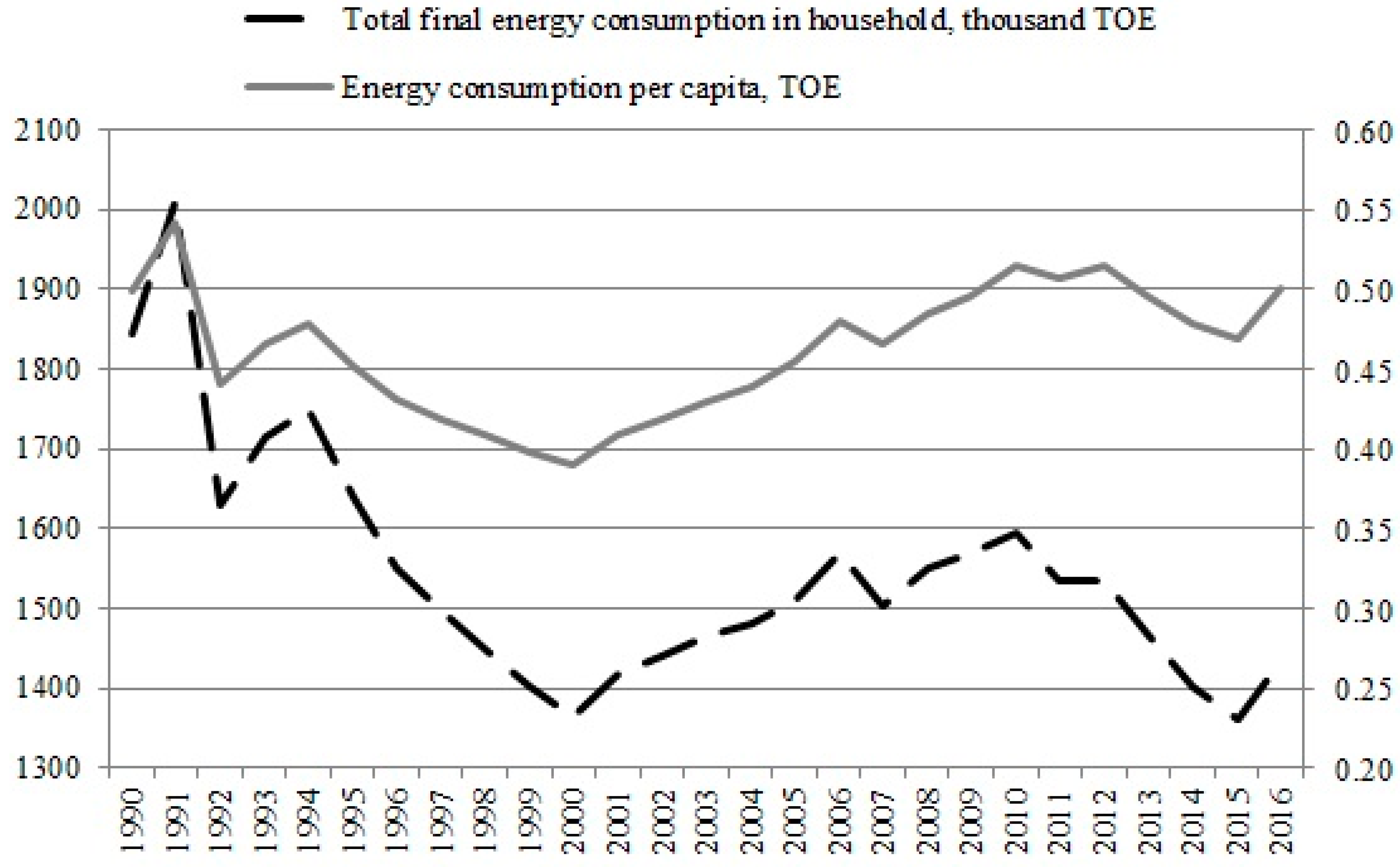
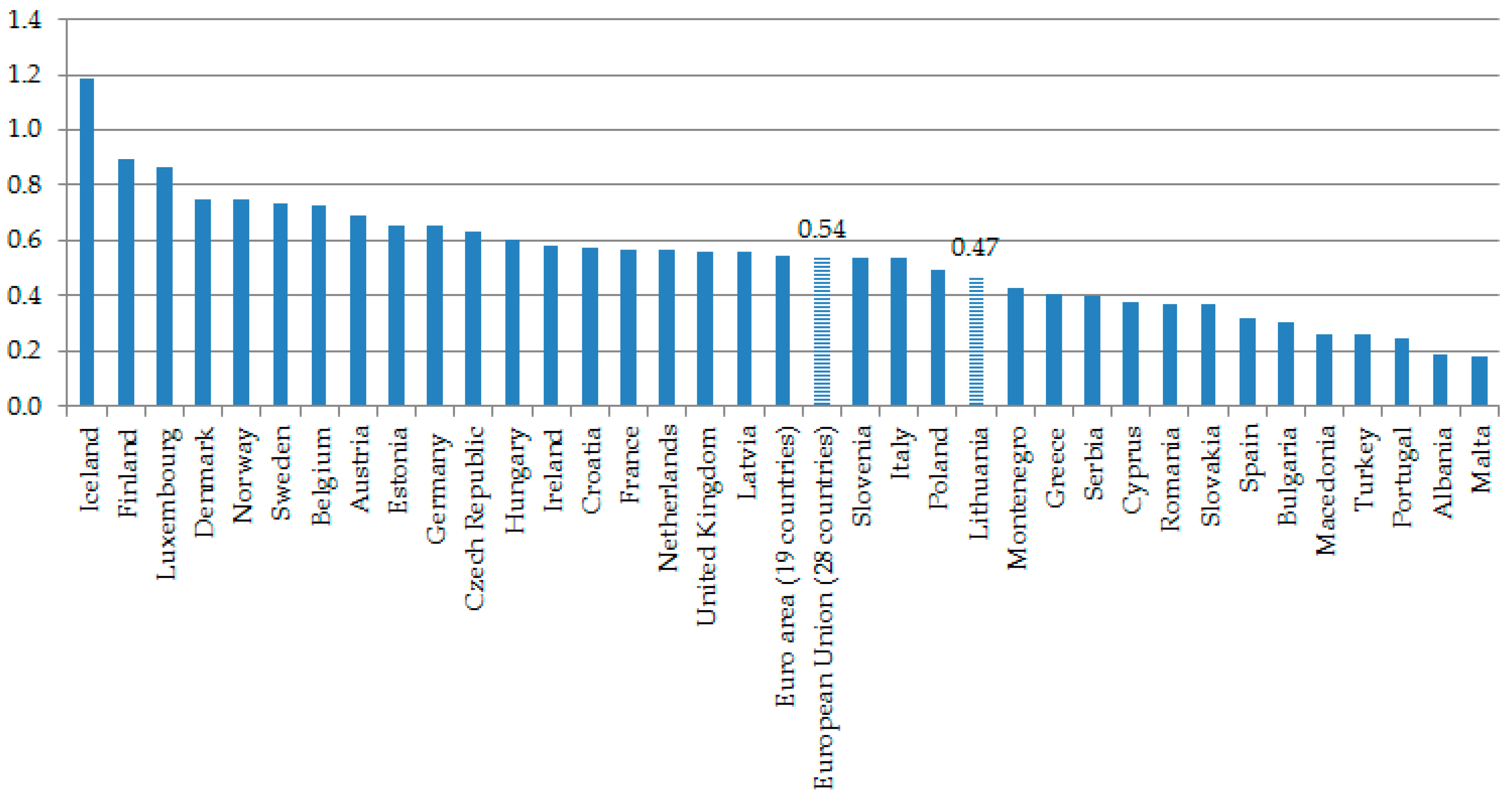




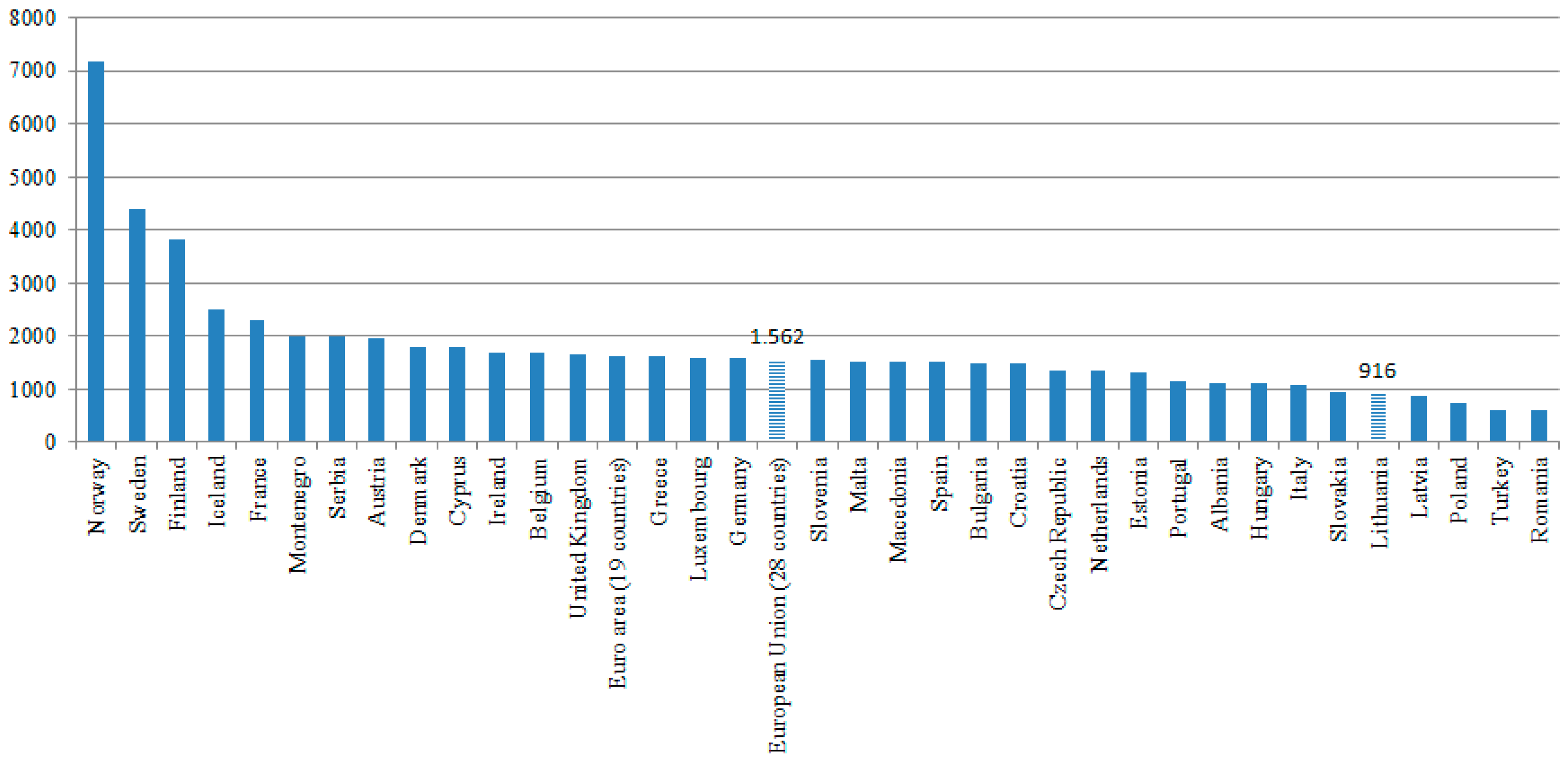
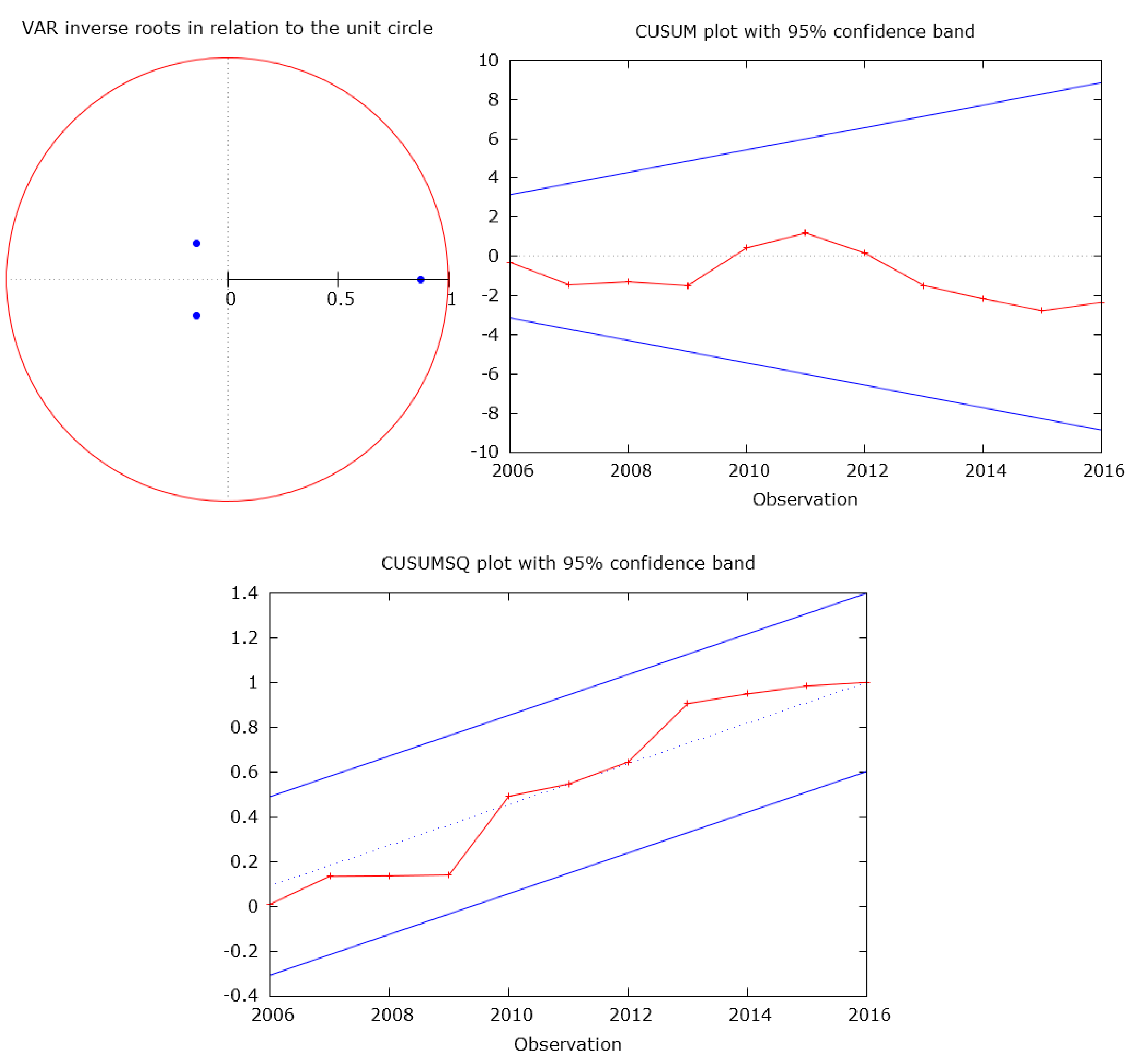
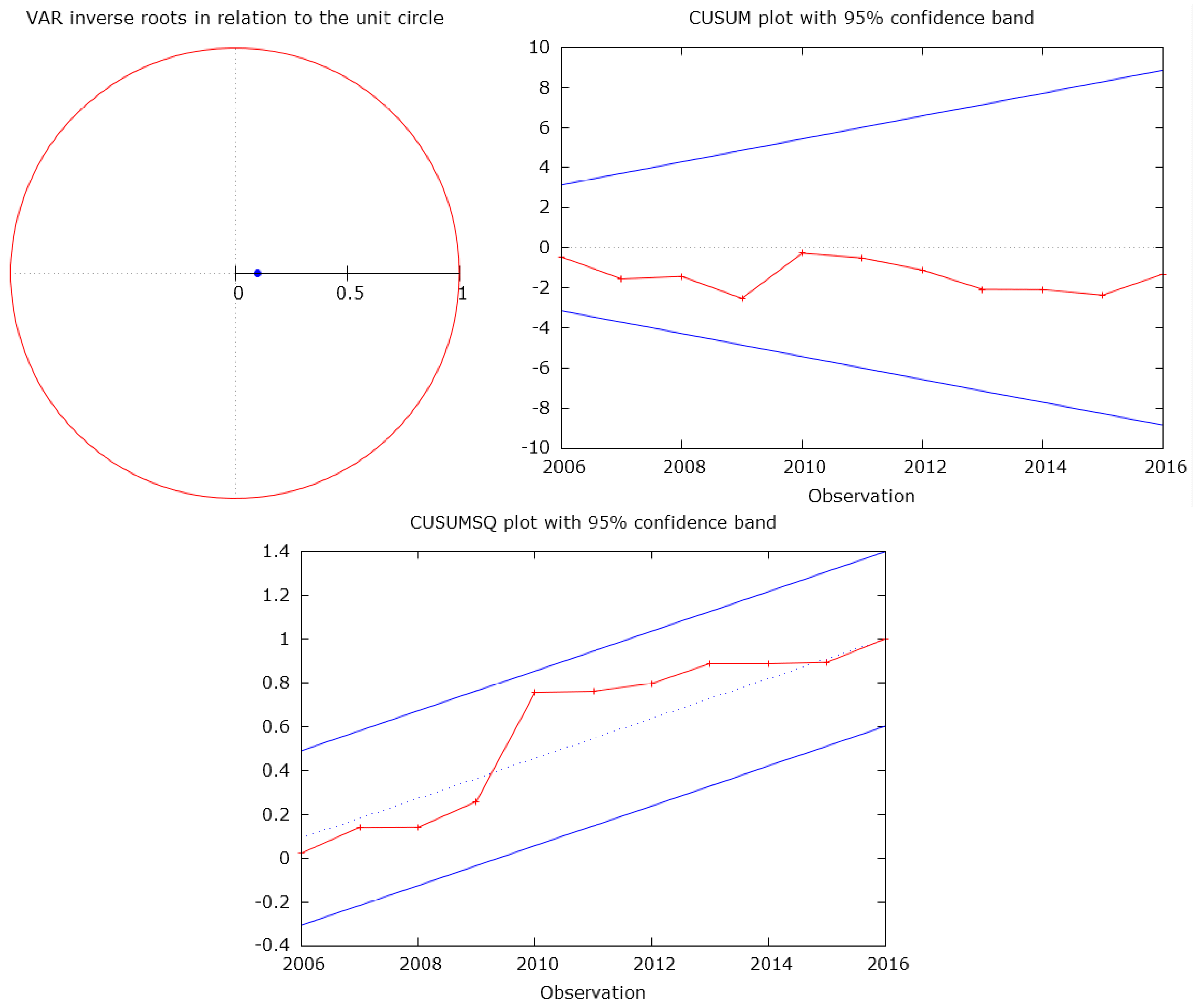
| Social or Economic Indicator | Integration |
|---|---|
| Residential electricity consumption per capita | I(1) without constant |
| Stock of dwellings | I(1) without constant |
| Useful floor area per capita | I(1) without constant |
| Electricity prices for domestic consumers with taxes and levies | I(1) without constant |
| Electricity prices before taxes and levies | I(1) without constant |
| Heating degree days | I(0) with constant |
| Unemployment | I(1) without constant |
| Ratio of the registered unemployed to the working-age population | I(1) without constant |
| Gross monthly average earnings | I(2) |
| Net monthly average earnings | I(2) |
| Basic monthly wage | I(0) with constant |
| Basic social benefit | I(0) with constant |
| Average disposable income per month in cash and kind per household | I(2) |
| Average disposable income per month in cash and kind per capita | I(2) |
| Average disposable income per month in cash per household | I(2) |
| Average disposable income per month in cash per capita | I(2) |
| A heavy burden of housing expenses on households | I(1) without constant |
| A slight burden of housing expenses on households | I(1) without constant |
| Not burden of housing expenses on households at all | I(1) without constant |
| At-risk-of-poverty threshold, type of household: single person | I(2) |
| At-risk-of-poverty threshold, type of household: 2 adults with 2 children younger than 14 years | I(2) |
| At-risk-of-poverty gap | I(1) without constant |
| At-risk-of-poverty rate | I(1) without constant |
| GDP at current prices | I(1) without constant |
| GDP per capita at current prices | I(1) without constant |
| Mean equivalised net income | I(2) |
| Median equivalised net income | I(2) |
| Overcrowding rate | I(1) without constant |
| Housing cost overburden rate | I(1) without constant |
| Social or Economic Indicator | Cointegrating Regression | ||
|---|---|---|---|
| Without Constant | With Constant | With Constant and Trend | |
| Stock of dwellings | 0.8344 | 0.7644 | 0.08844 * |
| Useful floor area per capita | 0.2499 | 0.8042 | 0.1281 |
| Electricity prices for domestic consumers with taxes and levies | 0.6416 | 0.1102 | 0.8356 |
| Electricity prices before taxes and levies | 0.39 | 0.09263 * | 0.8415 |
| Unemployment | 0.1475 | 0.9456 | 0.4599 |
| Ratio of the registered unemployed to the working-age population | 0.01237 ** | 0.9243 | 0.5102 |
| A heavy burden of housing expenses on households | 0.01643 ** | 0.312 | 0.489 |
| A slight burden of housing expenses on households | 0.3778 | 0.7135 | 0.5206 |
| Not burden of housing expenses on households at all | 0.05084 * | 0.6264 | 0.4221 |
| At-risk-of-poverty gap | 0.09932 * | 0.5095 | 0.1202 |
| At-risk-of-poverty rate | 0.02983 ** | 0.7247 | 0.02881 ** |
| GDP at current prices | 0.006181 *** | 0.04325 ** | 0.2876 |
| GDP per capita at current prices | 0.1355 | 0.06163 * | 0.2336 |
| Overcrowding rate | 0.6122 | 0.2512 | 0.4341 |
| Housing cost overburden rate | 0.02673 ** | 0.2623 | 0.7254 |
| Null Hypothesis | Max Lag of VAR | p-Value of Ljung-Box Test | Probability of H0 |
|---|---|---|---|
| H0: ratio of the registered unemployed to the working-age population does not Granger-cause y * | 2 | 0.555 | 0.0127 ** |
| H0: y does not Granger-cause ratio of the registered unemployed to the working-age population | 2 | 0.48 | 0.3526 |
| H0: a heavy burden of housing expenses on households does not Granger-cause y | 2 | 0.476 | 0.0105** |
| H0: y does not Granger-cause a heavy burden of housing expenses on households | 2 | 0.562 | 0.5689 |
| H0: at-risk-of-poverty rate does not Granger-cause y | 1 | 0.907 | 0.3249 |
| H0: y does not Granger-cause at-risk-of-poverty rate | 1 | 0.751 | 0.2446 |
| H0: GDP at current prices does not Granger-cause y | 1 | 0.263 | 0.0188 ** |
| H0: y does not Granger-cause GDP at current prices | 1 | 0.533 | 0.5037 |
| H0: housing cost overburden rate does not Granger-cause y | 2 | 0.844 | 0.9770 |
| H0: y does not Granger-cause housing cost overburden rate | 2 | 0.409 | 0.2643 |
| Coefficient | Std. Error | t-Ratio | p-Value | |
|---|---|---|---|---|
| const | 5.95372 | 1.31267 | 4.536 | 0.1382 |
| −0.687914 | 0.285551 | −2.409 | 0.2505 | |
| −0.165628 | 0.07074 | −2.341 | 0.257 | |
| −0.141257 | 0.022921 | −6.163 | 0.1024 | |
| 0.099619 | 0.046063 | 2.163 | 0.2757 | |
| −0.652372 | 0.445884 | −1.463 | 0.3817 | |
| −0.0173455 | 0.179583 | −0.09659 | 0.9387 | |
| 0.057235 | 0.040701 | 1.406 | 0.3935 | |
| −0.398144 | 0.062584 | −6.362 | 0.0993 * | |
| Adjusted R-squared | 0.986680 | Schwarz criterion | −82.71503 | |
| F(8, 1) | 84.33608 | p-value (F) | 0.084030 |
| Coefficient | Std. Error | t-Ratio | p-Value | |
|---|---|---|---|---|
| const | 0.399903 | 0.28973 | 1.38 | 0.1949 |
| −0.502307 | 0.368351 | −1.364 | 0.1999 | |
| 0.134839 | 0.209446 | 0.6438 | 0.5329 | |
| −0.0379285 | 0.063739 | −0.5951 | 0.5638 | |
| −0.212269 | 0.40262 | −0.5272 | 0.6085 | |
| 0.113474 | 0.241696 | 0.4695 | 0.6479 | |
| −0.0484724 | 0.034821 | −1.392 | 0.1914 | |
| Adjusted R-squared | 0.460468 | Schwarz criterion | −59.63624 | |
| F(6, 11) | 3.418129 | p-value (F) | 0.037236 | |
| p-value of Ljung-Box test | l = 1 | l = 2 | l = 3 | l = 4 |
| 0.177 | 0.402 | 0.147 | 0.139 |
| Coefficient | Std. Error | t-Ratio | p-Value | |
|---|---|---|---|---|
| const | 0.623541 | 0.223251 | 2.793 | 0.0125 ** |
| 0.58513 | 0.022383 | 26.14 | 3.62 × 10−15 *** | |
| 0.02823 | 0.021073 | 1.34 | 0.198 | |
| Adjusted R-squared | 0.973696 | Schwarz criterion | −65.56116 | |
| F(2, 17) | 352.6668 | p-value(F) | 1.44 × 10−14 | |
| p-value of Ljung-Box test | l = 1 | l = 2 | l = 3 | l = 4 |
| 0.389 | 0.624 | 0.659 | 0.403 |
| Coefficient | Std. Error | t-Ratio | p-Value | |
|---|---|---|---|---|
| const | −0.00656340 | 0.020176 | −0.3253 | 0.7511 |
| 0.098994 | 0.337717 | 0.2931 | 0.7749 | |
| 0.287886 | 0.242526 | 1.187 | 0.2602 | |
| 0.304718 | 0.201117 | 1.515 | 0.1579 | |
| 0.02472 | 0.077465 | 0.3191 | 0.7556 | |
| 0.056222 | 0.076746 | 0.7326 | 0.4791 | |
| −0.737742 | 0.414539 | −1.780 | 0.1027 | |
| Adjusted R-squared | 0.480183 | Schwarz criterion | −60.30632 | |
| F(6, 11) | 3.617307 | p-value(F) | 0.031265 | |
| p-value of Ljung-Box test | l = 1 | l = 2 | l = 3 | l = 4 |
| 0.749 | 0.92 | 0.239 | 0.224 |
© 2018 by the authors. Licensee MDPI, Basel, Switzerland. This article is an open access article distributed under the terms and conditions of the Creative Commons Attribution (CC BY) license (http://creativecommons.org/licenses/by/4.0/).
Share and Cite
Vojtovic, S.; Stundziene, A.; Kontautiene, R. The Impact of Socio-Economic Indicators on Sustainable Consumption of Domestic Electricity in Lithuania. Sustainability 2018, 10, 162. https://doi.org/10.3390/su10020162
Vojtovic S, Stundziene A, Kontautiene R. The Impact of Socio-Economic Indicators on Sustainable Consumption of Domestic Electricity in Lithuania. Sustainability. 2018; 10(2):162. https://doi.org/10.3390/su10020162
Chicago/Turabian StyleVojtovic, Sergej, Alina Stundziene, and Rima Kontautiene. 2018. "The Impact of Socio-Economic Indicators on Sustainable Consumption of Domestic Electricity in Lithuania" Sustainability 10, no. 2: 162. https://doi.org/10.3390/su10020162




